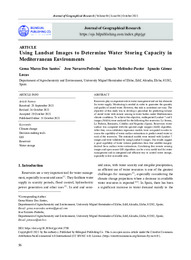Por favor, use este identificador para citar o enlazar este ítem:
https://hdl.handle.net/11000/34729Registro completo de metadatos
| Campo DC | Valor | Lengua/Idioma |
|---|---|---|
| dc.contributor.author | Marco Dos Santos, Gema | - |
| dc.contributor.author | Navarro-Pedreño, Jose | - |
| dc.contributor.author | Meléndez Pastor, Ignacio | - |
| dc.contributor.author | Gómez Lucas, Ignacio | - |
| dc.contributor.other | Departamentos de la UMH::Agroquímica y Medio Ambiente | es_ES |
| dc.date.accessioned | 2025-01-16T19:33:10Z | - |
| dc.date.available | 2025-01-16T19:33:10Z | - |
| dc.date.created | 2021-10 | - |
| dc.identifier.citation | Journal of Geographical Research | Volume 04 | Issue 04 | October 2021 | es_ES |
| dc.identifier.issn | 2630-5070 | - |
| dc.identifier.uri | https://hdl.handle.net/11000/34729 | - |
| dc.description.abstract | Reservoirs play an important role in water management and are key elements for water supply. Monitoring is needed in order to guarantee the quantity and quality of stored water. However, this task is sometimes not easy. The objective of this study was to develop a procedure for predicting volume of stored water with remote sensing in water bodies under Mediterranean climate conditions. To achieve this objective, multispectral Landsat 7 and 8 images (NASA) were analyzed for the following five reservoirs: La Serena, La Pedrera, Beniarrés, Cubillas and Negratín (Spain). Reservoirs water surface was computed with the spectral angle mapper (SAM) algorithm. After that, cross-validation regression models were computed in order to assess the capability of water surface estimations to predict stored water in each of the reservoirs. The statistical models were trained with Landsat 7 images and were validated by using Landsat 8 images. Our results suggest a good capability of water volume prediction from free satellite imagery derived from surface water estimations. Combining free remote sensing images and open source GIS algorithms can be a very useful tool for water management and an integrated and efficient way to control water storage, especially in low accessible sites | es_ES |
| dc.format | application/pdf | es_ES |
| dc.format.extent | 10 | es_ES |
| dc.language.iso | eng | es_ES |
| dc.publisher | Bilingual publishing group | es_ES |
| dc.rights | info:eu-repo/semantics/openAccess | es_ES |
| dc.rights | Attribution-NonCommercial-NoDerivatives 4.0 Internacional | * |
| dc.rights.uri | http://creativecommons.org/licenses/by-nc-nd/4.0/ | * |
| dc.subject | Climate change | es_ES |
| dc.subject | Decision-making tools | es_ES |
| dc.subject | GIS | es_ES |
| dc.subject | Reservoir | es_ES |
| dc.subject | Water storage | es_ES |
| dc.subject.other | CDU::6 - Ciencias aplicadas::62 - Ingeniería. Tecnología | es_ES |
| dc.title | Using Landsat Images to Determine Water Storing Capacity in Mediterranean Environments | es_ES |
| dc.type | info:eu-repo/semantics/article | es_ES |
| dc.relation.publisherversion | https://doi.org/10.30564/jgr.v4i4.3780 | es_ES |

Ver/Abrir:
JGR-3780_Vol 4_Issue 4_2021.pdf
920,91 kB
Adobe PDF
Compartir:
 La licencia se describe como: Atribución-NonComercial-NoDerivada 4.0 Internacional.
La licencia se describe como: Atribución-NonComercial-NoDerivada 4.0 Internacional.
.png)